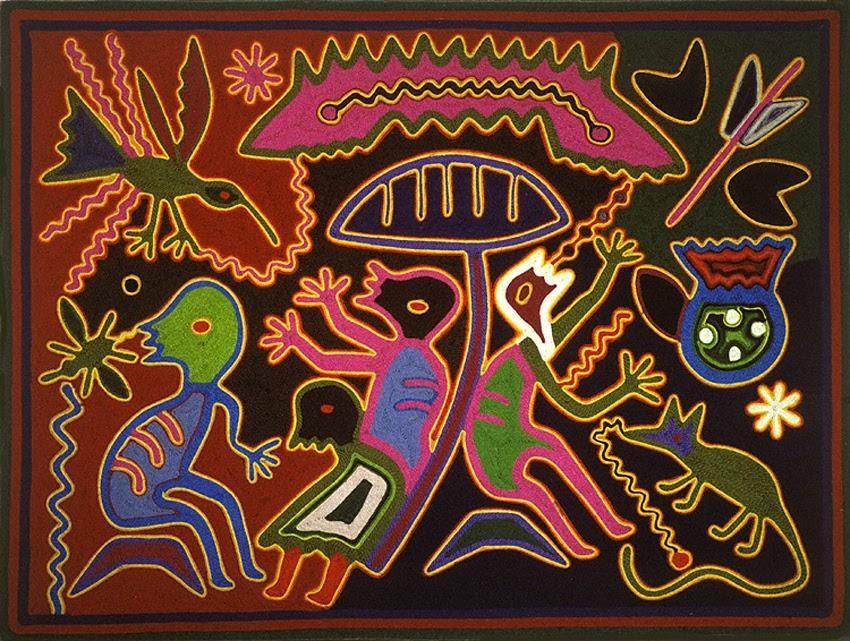The Dead Gather Under a Mushroom/Mik+te mem+yukuxexe+riwa yekwá het+a

The mushroom (at center) represents the soul of the dead that, like shadows, in invisible form, return to visit the places they once enjoyed as living beings and where they left their hearts imprinted, of their memory (at top right two hearts are rendered). The mushroom, under whose shadow they gather to rest, is an ‘itáikari, or a fright; knowing that to eat it causes death, but, nonetheless, sometimes we eat anything in life.
The dead person (to the right) feels his tired soul. Sitting next to the mushroom, he thinks and directs his words (knotted thread that emerges from his mouth) toward the sky, Taheimá (pink form in the upper part of the painting). He thinks: “when will I finish my journey in this world? I am tired of revisiting so many places where I have walked. Before, it was easy to collect fruit because I knew the things that could be eaten and for that reason I cut them, but I never thought I’d be punished for this upon my death. What hurts me the most is that we never return to the joyful place, where things are eaten with happiness”.
The soul of the dead visits the places where he walked in life, where he laughed, where he harvested wild tuber and enjoyed the flavor of the roots and fruits. In life, the person killed badgers hitting them with sticks and rocks, they also agitated the water and spilled it when it was full. Now he must return to the place where the badger’s blood was shed (below at right, with blood coming out of its mouth), and he must clean the marks. Where he spilled water from its jug, he must erase the trace (the flower below the jug), because there his heart is in the wind, there his face was marked. We need to go about cleansing our face where we neglected life; if we cut a fruit, we need not throw it away before finishing it, just because we feel satisfied.
Some Wixaritari do not have much to travel after dying because they did not leave their homelands to wander in far off places. They immediately become birds (upper left); so they arrive to the sky “with everything and feathers, with a complete body”.
Nonetheless, the rest follow the heavy traces of their previous actions and “fall apart” tired of wandering in shadow form. On the left side, two dead lean against the mushroom; one wants the other to carry him on his back because he no longer can walk, but his friend is also tired and cannot carry him. Another dead person, seated in front, is begging, looks at the path (which sets out like a thread from the insect’s head) and thinks that there is still a long road to travel. Before being able to grab the thread in the sky, where the soul’s salvation depends, they must also find the arrows (upper right) they lost when they shot them with their bows.
Explanation and Interpretation by Juan Negrín as explained in a tape-recorded conversation with José Benítez Sánchez. Text and Image ©Juan Negrín 1973 - 2025. All rights digital and print reserved.
---
Yekwá (hixiata) pihiki tukari ‘iniariya mikite, ‘etiri hapai, mekapuhekiá, me‘iwatati mekananu’uwani kewa meripai mematitekai meyutemamawieti kewa ‘iyari yeiyari memeku‘eiri, yu‘iyaritiarika (miti‘axé tserieta hutati‘iyari kani‘utiarieka). Yekwá ‘atirieyatia meniuyukuxexeiriwani me‘uxipikuti, kani‘itaikaritini; timateti kename pe’ikwa‘á kename pe‘imiiya, yatiti penitakwaimiki tsepá tita.
Mikí (tserieta) tukari kaneu‘uxeni. Yekwá ‘aurié ‘ukaiti, yuhiaweti (wita tetananayeneka tapieti) muyuawitsié neutiniukani -Taheimá (yutsikimaiye kaniwewieka miti‘axé), tiniku‘eriwani: “¿kepauka neputitahayewa nemukuyeika kiekaripa? Nepu‘uxe naitsarie nemukuyeika meripai nemanuyeikakai. Meripai nemika‘uxekai nemakuyeikakai ‘ikwaxita, piní nemiretimá mitikwaiwakai, ye‘umieme nenika‘inini, hatsua pai nepukatiu‘eri kename netikwinitiarieni ye‘umieme ‘ariké ne‘umiku. Matsi netsihekukukuine hatsua tekwahanuaxiani temanu‘uwakai tetatemamawieti, temawierikaki tita mitiuyukwaixime.”
Mikite wakipiri kananunuwani kewa meme‘uwakai memayenenierekaitsié, kewa metanawekai, kewa yeri meti‘inekai mana tsimire’iniatakai ti‘ikwaxeme tsiere. Pai tiuyeikati, haitsiri watakukuyakai kiyeki watiwayatitetexiki tsiere, há mumuinakai mitiyeuriwakai xika ‘utahiné. Hiki ta kanenuitiaxia miki kewa haitsi xuriya metaxiri (hetiana kanihekiaka tserieta tetana xuriya kaniwayeneikani), yeiyarieya kanikuyeitiamiki. Kewa ha metayeuri xukuritsié, ‘uxaya kanikuyeitiamiki (tuturi xari hetia), ‘ekatsié ‘iyarieya mana kaniuyeikakaitini, mana kana‘ire tewiyari. Teniye‘itiximekuni tayeiyari kewa yiki temeyuri; xika ‘ikwaxi tehakatuni, nai tekataxiwetitekapeihipani, teni huxaka.
Hipati wixáritari waikawa mekaputikika mekwimeri, takwié waikawa kwiepa me‘utikineme tewa. Miki xeimieme metenaye‘atiwani wikixi menaye xiriweni (miti‘axé ‘utata); kariki meneti‘axeni muyuawitsié “naime hau‘aniyakameki”.
Hipati kuxi pai meteneiweiyani huye meripai memite‘uhukai hapai meniyenuaximeni ‘etiri hapai huyetá me‘uhuti. Tserieta mikite yuhutati hura meni‘uweni yekwá mekwatiku; xewiti naime ‘iyá ke‘ititini yuwarima pika‘uyeiwe ri, iwaya kwa‘itimiki ‘arí ri pu‘uxe. Xewiti mikí, huta ‘akaiti, niwauka, huyé nixeiyani (kanikawiwieka wita xaipi mu‘uyatsié hawieti) tiniyukuhiaweni waikawa kuxi hauyewetsé mukuyaní.
Mexi kuxi wita kawiyawe yuawitsié mieme, tukari kewa metawikweni, ‘irite tsiere menikaxeiyakuni (miti‘axé tserieta) menitaxiri yutupiki.





